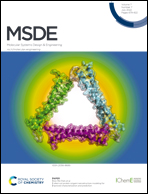Monitoring the dependence of the photovoltaic properties of dye-sensitized solar cells from the structure of D–A–π–A-type sensitizers with a 9-(p-tolyl)-2,3,4,4a,9,9a-hexahydro-1H-1,4-methanocarbazole donor building block†
Abstract
The potential of dye-sensitized solar cells (DSSCs) based on synthesized D–A–π–A-type dyes with a 9-(p-tolyl)-2,3,4,4a,9,9a-hexahydro-1H-1,4-methanocarbazole building block as a donor fragment was explored. The influence of the structure of the internal acceptor and of the π-spacer on the optical and photovoltaic properties of the NIK series sensitizers was revealed. Dyes based on benzo[c][1,2,5]thiadiazole, which is a stronger electron-withdrawing unit than 2,3-diphenylquinoxaline, showed a bathochromic shift of the absorption band corresponding to intermolecular charge transfer, and incorporation of the 4,4-diethylhexyl-4H-cyclopenta[2,1-b:3,4-b′]dithiophene π-bridge (NIK119) instead of thiophene (NIK88) resulted in the highest extinction coefficient among all the studied dyes in the UV-vis spectra. The presence of branched alkyl substituents in NIK119 as well as in NIK99 did not allow reaching a high absorption of these sensitizers on a TiO2 surface, so the solar cells based on them showed low short-circuit current values and, as a consequence, a low power conversion efficiency (PCE). On the other hand, the absence of bulky groups in the structure of the sensitizer sharply increases charge recombination and dye aggregation, which causes the dramatic drop in PCE for NIK88. The optimal ratio between the concentration of dyes on a TiO2 surface and the electronic effects of individual blocks was achieved for the NIK97 dye based on unsubstituted 2,3-diphenylquinoxaline, for which a PCE value of 5.68% was obtained using CDCA as a co-adsorbent.



 Please wait while we load your content...
Please wait while we load your content...